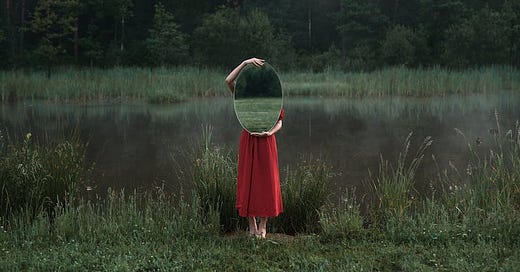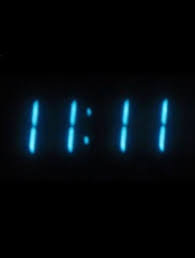Exploring every rabbit hole there is. For more wanderings, become an Alice in Futureland subscriber—it's free.
🍄 AudioDose Alice on Sonic Mushrooms: Listen to Awaken your third eye
🎧 Alice podcasts: Consciousness and the Quantum Mind with Johnjoe McFadden
📘 Alice books: Tuning into Frequency: The invisible force that heals us and the planet
Hello, we’re Alice and we are always in a state of wander. In 2002, Alice visited physicist F. David Peat, one of the most interesting and innovative thinkers of our time. He was a quantum physicist, writer and teacher who founded The Pari Center for New Learning in 2000. Peat wrote more than 20 books which have been translated into 24 languages, as well as numerous essays and articles. In 1971-72, he spent a sabbatical year with Roger Penrose and David Bohm, and thereafter his research focused on the foundations of quantum theory.
“We are much more than our cognitive strategies.”
Peat’s reflective look at life’s synchronicities points out there is something deeper at work in the universe and in our personal lives than chance or even rational thought. Through his stories he shared the relationship between science, art, creativity and culture. Peat died 2017 in Pari, Italy.
Our visit with F. David Peat:
“It is, in fact, very difficult for us to tolerate silence. We get very agitated when there’s silence. Silence is difficult to tolerate for us because we want to act. And I’m suggesting there should be a creative suspension. In the creative suspension you begin to listen, you listen to yourself, what’s going on inside you.”
“There’s a nice thing that Native Americans talk about, ‘coming to knowing.’ To us, knowledge is a set of facts, information, stuff you can get downloaded off the Internet. I talk about active information, so giving information a different character. Some of the discussions that I’ve had with therapists: Where does the healing take place? There’s a patient and a therapist, where is the healing? Does the therapist heal the patient? Or is there a creative act involving both of them? There’s the metaphor of being put in the crucible, like in the alchemical transformation, that both the patient and the therapist have to be transformed together, that it’s a creative act. So in that sense, there’s that sense of creativity involved. In another sense, I’m suggesting that the information itself can be something different than passive. It can be active. So information itself could have an activity. It could, in that sense then, as Native people would say, it’s a being. Like knowledge could be a being. It has its own existence.”
How do we apply it to ourselves? Listen to what nature has to say.
“I can follow the Newtonian way of doing an experiment in which an experiment puts nature into an artificial situation and gives me answers. Or I could take Goethe’s view, which Goethe says, ‘Listen to what nature has to say to you.’ So what Goethe would say is, rather than taking this plant and putting it in the laboratory and fiddling with it, you just go and look at that plant in nature, and at some point something will reveal itself; the plant will tell you something. So there are two very different ways to gain knowledge. One is to have a dialogue with nature, to speak with nature and have nature speak to us. And the other is to sort of impose your will upon nature, and put nature in artificial situations.”
The more deep question is, what is a subtle energy?
“We talked about active information. The idea that information has an activity. It isn’t something simply passive like data, or words in a book. One aspect of active information would be the body’s entire immune system. The immune system is about as complicated as the human brain, and there are a lot of similarities between the chemicals of the immune system and those of the neurotransmitters. So, in that sense, you could think that we have two brains. We have one up here in the head and we have something else distributed throughout the whole body, which is a pattern recognition system. It’s looking for things coming in from outside. So that would be a two level system. But there’s another thing you could say, is there’s some kind of subtle energy or active information that can act upon the metabolic processes of the body. And can maybe even act in the synapses in the brain.”
“We could ask about mind and consciousness, and what is mind? Is mind separate from matter? Like with Descartes, the extended stuff is matter, and the thinking stuff is mind and the two are separate. I would say our knowledge of matter is somewhat restricted if you go with Descartes. Matter is just extended stuff. Matter is hard things, like cups, and saucers, and stones. If you see matter more closer to processes, if you talk about the implicate order and the explicate order, and you say, that matter is closer to processes. Matter has very subtle levels. There’s matter, there’s energy, there’s active information. Now with active information, you could talk about subtle energy. So already you’re saying that inseparably connected to matter is this whole notion of what we could call subtle energy, or active information, or something to do with proto-mind. So it’s there from the beginning. Proto-mind is there from the beginning. Certainly organisms evolved to have more complex nervous systems, and maybe these complex nervous systems are ways in which mind can operate in the realm of matter. Just as much as, say, you want to take these images coming from a television transmitter. So there’s information. It’s about a movie. It’s got music on and visuals and words. But to make that manifest you have to build a television set with a certain level of complexity. The set has to have a certain level of complexity. Otherwise, no matter how much you broadcast, you never see any pictures. And it has to work properly, otherwise the picture is distorted. Well, you could similarly say with the human brain, is the human brain creating consciousness, or is the human brain a device which allows mind to manifest itself in the explicate world, in our world? Is consciousness emerging out of the whole body, and out of something beyond it, and making use of the mind as the signal from the transmitter makes use of the television set to manifest the images? So these are questions.”
“If you happen to hold that human consciousness is no more than the epiphenomenon, or secretion, of our individual brains then you are more or less trapped in your own skull. But if consciousness is open, if it can partake in a more global form of being, if it can merge with the natural world and with other beings, then, indeed, it may be possible to drop, for a time, the constraints of one’s personal worldview and see reality through the eyes of others.”
The operation of mind.
“Most of the exciting things that go on are not taking place in awareness. If you equate consciousness with awareness—I’m aware that I’m talking to people here, I’m aware that there are books behind me, I’m aware that there’s been a wind outside—but beyond that, there’s a lot more going on that I’m not aware of. The words I’m speaking now, where do they come from? Are they coming because my mind is thinking them out carefully and analyzing them? Partly. But partly it’s coming from somewhere beyond that. Some of the most profound and exciting and creative things we do have nothing to do with awareness. They’re taking place outside of awareness. If by consciousness you mean awareness, then consciousness is not very important. The whole operation of mind is important. One neat thing is the study of artificial intelligence. How do machines think? How do machines recognize faces? How do they do this, how do they do that? That gives us some clues as to maybe how our own minds work. And what I find so interesting is that there’s this big move to build computers that will play chess and beat a human expert. So we tend to think that chess is one of the cleverest things we can do. Like one of the neatest things. And I think it’s because it gives you a headache to do it, because when you’re doing chess you’re thinking and it gives you a headache. But I think that’s a really rather superficial thing, playing chess. And much more deeper is being able to catch a ball, or being able to run and jump and catch something, or to recognize what the weather’s going to be like tomorrow by listening to the wind, or looking at the clouds. I think those are things that are very deeply programmed in us. Language, being able to speak, to say things creatively, these are much more profound than being able to play chess or do mathematics. The things that conscious awareness does are not all that profound. And the things that are much deeper—like creating a human society, like people coming together and having emotions together, like having a symphony played or going to a play and having a play performed—those are much more deeper things to do with human interactions, human creativity, using all the senses together. I think they’re much more important than doing hard things like mathematics and playing chess. They’re only hard because they give us a headache. I don’t think they’re very profound in the long run.”
Synchronicities
“Synchronicities maybe happen only once or twice in your life. They’re very profound. They are a bridge between your outer world, your external world of your habits, your patterns, what’s going on outside, your friends, and your inner world. Somehow that’s bridged, in a mysterious way. And the whole thing is full of meaning. So it’s like, James Joyce would say the word epiphany, it’s an opening up. It’s a little thing you notice. So I think synchronicities are profound things…true synchronicities are.”
“People come to me and say, ‘Look, I was in a taxi crossing the Brooklyn Bridge and the guy’s name was Craig Petrofski. And I realized yesterday that I spoke to a Craig Petrofski, or I saw his name in the telephone directory. Wow! That’s a synchronicity!’ That’s just a trivial coincidence. I like the word that James Joyce used which was an epiphany. So an epiphany is an opening up, it has a great transformative quality. Synchronicity is something that’s deeply meaningful to the person that has it. It’s something that happens when your inner world and your outer world connect. When maybe you have a dream, and you see the dream connected in something outside. Or you have the intimation of meeting someone and the person arrives from your past, and it’s not just an ordinary person, this person has a great influence on you. Synchronicities are deep connections. The famous example from Carl Jung is that there’s a woman patient who for a long time has been resisting treatment. And she talks of a dream in which she dreamt of a scarab, a golden scarab. And a scarab has a lot of importance in Greek, in Egyptian mythology, a rebirth. And Jung hears a tapping behind him. And he looks at the window and there’s an insect tapping. And he opens the window, and a golden scarab flies in the room. And the woman sees the scarab and says, ‘That’s the scarab in my dream.’ She somehow is transformed under therapy and radically changes. So it’s something like that, an inner working, the dream, and something manifesting itself in the outer world, which was seen more than a coincidence, very meaningful. And that transformed that woman’s ability to go on with her therapy. There are many examples the therapist can give you about this. There are these deep connections. And these are very much more profound than just simple coincidences: they’re profound, they’re very deep, they’re full of meaning.”
“One type of synchronicity is that a certain point in your life you meet a person who opens a door for you. So a synchronicity can be a meaning. It’s that you have something deep inside that needs catalyzing, or needs giving some sort of symbol to it. And that symbol could be a book you read, or a person you meet. As you would say, that person opens a door for you, but they can’t go through the door with you. You pass through the door. Another way of thinking of synchronicity is it’s a marker in time. You can be in your life doing repetitive things. We talked about people in strange attractors, people trapped by an archetype. So you can be going from job to job, in a world in which you may be a little hostile to authority figures. You could be in a relationship, and you get out of that, and you get into another relationship, which seems to have the same pattern. So you can have a pattern in your life. Synchronicity comes along and breaks it. It’s a marker in time. There’s a before and an after. Things are different afterwards.”
“Synchronicities, epiphanies, peak and mystical experiences are all cases in which creativity breaks through the barriers of the self and allows awareness to flood through the whole domain of consciousness. It is the human mind operating, for a moment, in its true order and moving through orders of increasing subtlety, reaching past the source of mind and matter into creativity itself.”
Thank you, F. David Peat!
What else we are wandering…
📘 Synchronicity: The Bridge Between Matter and Mind by F.David Peat
With fascinating historical anecdotes and incisive scientific analysis, this important work combines ancient thought with modern theory to reveal a new way of viewing our universe that can expand our awareness, our lives, and may well point the way to a new science for the twenty-first century.
🧠 YUP! We have all wondered…Temporal synchronicity revolves around the alignment of events in time. This could manifest as seeing repeated numbers like 11:11 or encountering significant dates, these are signs that serve as a cosmic confirmation, urging individuals to pay attention to the unfolding moments in their lives.
Craving more?
📘 Alice in Futureland books
🎧 Alice in Futureland podcasts
👁🗨 Coincidences with Jacques Vallée
Thanks for tuning in.
For more wanderings, become an Alice in Futureland subscriber—it's free.
Invite your friends to this mad tea party and let's see how many things we can learn before breakfast.
©2024 Alice in Futureland









